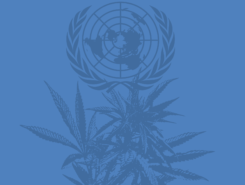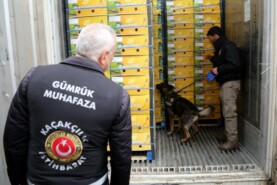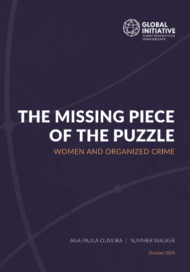Posted on 24 Jun 2019
As the UN moves ahead with the next decade of drug policy, combating drug trafficking will remain high on the international agenda. While states largely still agree to address this challenge together, the world around them is changing and the risk is that they will stick to the same old ways of doing business. This UN International Day Against Drug Abuse and Illicit Trafficking, commonly known as World Drug Day, we ask whether the international community has learnt anything from the last 10 years of flawed drug-policy responses.
In March 2019, the UN rubber-stamped the next 10 years of
international drug policy at the Ministerial Segment on drug policy at the
Commission on Narcotic Drugs (CND) in Vienna. Although it is technically a
consensus document, the short ministerial
declaration agreed upon by states sanctions a way forward that is likely to
produce a number of outcomes around the world. Responses will become more
divergent as regions and countries (as well as cities and provinces) take their
own different approaches to drug markets.
While 2019 was significant as the 10-year target date of the 2009
Political Declaration and Plan of Action on countering the world drug problem,
its policymaking significance became somewhat overshadowed by the 2016 UN
General Assembly special session on the world drug problem (UNGASS 2016).
Mexico, Guatemala and Colombia had asked for the 2019 high-level meeting to be
brought forward to 2016 owing to the urgency of drug-related issues in Latin America,
and the session produced an outcome document with policy guidance on
wide-ranging problems.
As a result, the recent 2019 meeting lost some of its clout as a
policymaking moment, but some steam was also lost due to gridlock over where
drug policy should go. In 2016, the UNGASS outcome document was hailed by many
as a stepping stone towards a more comprehensive perspective on drug policy –
one that encompasses human rights, public health and development. Not soon
after its adoption, a number of states that prefer the status quo began to lobby
against this wider policy focus. This forced governments to seek out where they
have common ground in 2019 and resulted in a brief ministerial statement that
encourages the implementation of all recommendations from 2009 onwards with a
tacit understanding that states and groups of states will choose their own
directions going forward.
In the next 10 years, then, observers will see states employing diverse
responses and policies domestically, bilaterally and internationally (take, for
instance, Canada’s stated commitment
to stop the illegal movement of its legal cannabis products across borders).
Playing by the rules of the international system while operating outside of it,
or reforming it, makes for complicated policy choices, and favours deference to
the old ways of doing business, because decades of policy and the UN treaties point
this way.
The more things change …
One area where states have not strayed too far from a common
position is in the commitment to combat drug trafficking. With some exceptions,
even the most liberal proponents of regulation still emphasize the need to
tackle trafficking and organized crime.
What is meant by this, however, is not always the same depending on whom
you speak to. Some government actors view this as an opportunity to reinforce
law-enforcement approaches, often in the context of populist political regimes.
And this is happening in an era of growing drug production in the Andes and
Central Asia, with enormous implications for several regions, such as East
Africa, as recently
documented by the GI. At the same time, civil society has not fully
grappled with the fact that law enforcement will continue to address organized
criminal activity and, in this, drug-policy changes will not fully replace the
role of law enforcement in this larger equation.
Long-standing links between organized crime and drug markets will
not disappear quickly, but they will shift as drug policies change and criminal
groups adapt, and in fact this calls for more nuanced law-enforcement responses.
This is now a debate that civil society should actively engage in. The focus
here must be to emphasize that responding to organized crime requires a spread
of policy tools, including development, political engagement, civic activism
and law enforcement. Failing to approach the challenge in this way will result
in, and indeed in some places has become, a new ‘war on drugs’, although packaged
differently.
When considering drug policy and organized crime, several issues
intersect, pointing towards increasing complexity over the next 10 years. Though
many countries now reject the terminology, a war on drugs, now framed as
fighting drug trafficking or organized crime, will continue. It is likely that
approaches by individual countries will be defined by responses to trafficking
ranging somewhere along a continuum from drug war to ‘drug war lite’. But, what
this approach will have in common is to continue to emphasize enforcement
responsibility towards the source and trafficking regions. The result will be a
lost opportunity in the discussion: the more things change, the more they
remain the same, at least in terms of global law enforcement.
The cannabis case
Lessons from the unfolding cannabis debate will, for better or
worse, reverberate through future drug policy discussions for some time. At the
UN, states are now discussing and even fighting over cannabis regulation, which
was largely ignored in 2016. At the same time, this debate is largely binary,
rather than addressing the nuanced changes that cannabis regulation will bring.
Nevertheless, disagreements at the UN will not stop regulation.
Cannabis is legal
in some form in over 30 countries and in 33 states in the US. In the western
hemisphere, Canada and the entire west coast of the US have legalized
recreational cannabis, and Mexico is considering what its regulation will look
like. The patchwork nature of cannabis regulation impacts a range of issues,
such as access to banking, competing legal frameworks and new smuggling
dynamics. These have implications for shifts in illicit markets – from
small-scale dealers to cartel business models. Some of these markets have moved
from total prohibition to large-scale corporate markets, which raises questions
about inclusion of groups like cannabis farmers and others for whom cannabis cultivation
is a livelihood strategy. It is possible that regulation occurs while the
underlying dynamics of exclusion persist, prompting new grey or illicit market
strategies, and possibly reproducing the same policy responses that perpetuate
structural inequalities. In this way, cannabis regulation has implications that
span domestic and transnational crime dynamics, development objectives, health
agendas and social exclusion paradigms.
New era, old policy?
The cannabis example alone clearly exemplifies a need for strategic
policymaking in a shifting environment. As some states consider smarter drug
policies, focused on the individual and society, they will have to consider policy
responses to trafficking and production, and not just drug use.
There is a risk that the ‘gains’ to be made in combating drug
trafficking will still be sought where the vulnerable are easier to target,
particularly in countries where the drug response remains connected to political
mobilization, entrenched bureaucratic interests and plain institutional inertia
– simply ‘the way things have always been done’. As the next major shift in
drug policy occurs, it will be critical to assess policies, including law-enforcement
responses, for their efficacy and their ability to ‘do no harm’.
Some governments could be taking a risk trying to balance a public-health
approach to drug use with increased efforts to combat drug trafficking without
defining what that approach will entail in the next 10 years. If new ideas are
not put on the table, they could continue to build an international regime
based on outdated approaches to trafficking and production. This will only
perpetuate many of the same negative consequences, such as increased revenue
for organized-criminal groups, the violence and corruption associated with drug
markets, newly emerging substances to circumvent new restrictions, and finding
solutions where the lowest hanging fruit is perceived to be – at the bottom end
of the drug economy in excluded and marginalized communities.
If combating trafficking remains a numbers game related to seizures
and arrests, governments will not be learning from their own stocktaking of challenges over
the last 10 years. New psychoactive substances continue to appear at alarming
rates, confounding front-line responses, from law enforcement to health
agencies. (In one afternoon in April
2018, more than 70 people overdosed in one US city from fentanyl-laced
synthetic marijuana.) A widening array of products, production and trafficking methods
will continue to develop alongside shifts in policy and restrictions. Drug production
and trafficking are intimately linked to wider socio-political landscapes and,
in many areas, are connected to the governance dynamics of organized-crime
groups. Responding to this requires a nuanced approach that draws from a broad spectrum
of policy responses, but which must seek to reduce harms to the most vulnerable
and build resilience in affected communities, including through better
enforcement. A new discussion on understanding and tackling organized crime in
the context of several decisive shifts in global drug markets is now overdue. Statements
to the effect that ‘we must now focus on organized crime’, as overall drug
policy evolves, miss the mark and risk replicating the mistakes of the past. Governments will need to continue to grow the evidence base around which
policies are effective and continue to widen the toolkit of responses to
illicit drug markets and organized crime more generally as drug markets change.



